Why natural materials are good for you and the planet
katiefischer.de
Natural materials not only have an enduring beauty, they can also help to create a happier, healthier home
Managing to be both timeless and on-trend, natural materials are an effortless way to bring harmonious earth tones and tactile textures into your living space. With sustainability in mind, it’s never been more important to use materials that come from renewable, properly managed resources, while also reducing our use of manmade, synthetic and petroleum-derived products such as plastics and polyester, or natural materials produced in unsustainable ways, such as non-organic cotton.
There’s also evidence to suggest that using predominantly natural materials to build and furnish your home has both psychological and physical benefits for wellbeing. The concept of biophilic design is a philosophy of architecture and interior design that embraces our innate attraction to anything derived from nature to create a more harmonious living environment.
On a practical level, using the most natural materials possible reduces the number of chemicals introduced into your living space in the first place, while materials such as wood have been shown to absorb toxins, removing them from the air we breathe indoors. Studies have also revealed that people report feeling calmer, less stressed and more energised in homes where natural materials predominate.
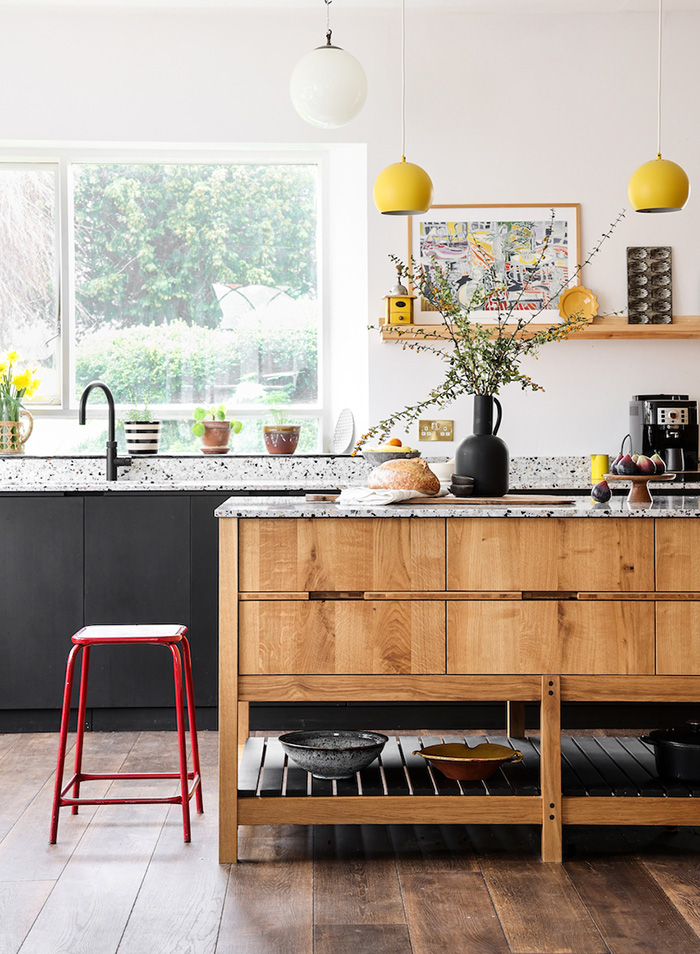
woodworksbrighton.co.uk
Wood
Chopping down trees never sounds very eco-friendly, does it? But when it comes to wood we have to think of the bigger picture. Wood is a highly renewable resource, especially soft woods such as conifers and pine which grow faster than hardwoods such as oak. The vast majority of the wood used in the UK comes from European forests, and as long as you always look for the FSC mark on any wood products you buy, it’s a sustainable choice.
Recycled wood is the most sustainable option, of course, with a growing number of companies sourcing and restoring reclaimed wood to make new products (check out the extensive collection at Sustainable Furniture). From bed frames made from scaffold boards to old factory floorboards rescued, restored and reused as flooring, shelves or cladding, there are so many possibilities for incorporating characterful reclaimed wood into your home. The trend for raw wood is still going strong, which means showcasing its natural beauty in its most rustic form – celebrating those flaws, knots and imperfections.
Wood is naturally energy-efficient and absorbs both heat and sound, making it warm, quiet and softer underfoot than materials such as tile or stone. Going natural for flooring instead of using manmade options, such as laminate, means it’s far less likely to contain toxic VOCs like formaldehyde, which may be emitted into your home for many years. The same is true for kitchen units and worktops, where again natural wood is a better option than composites or MDF. As a kitchen is likely to remain in situ for a number of years, it’s well worth spending a little extra on the real deal.
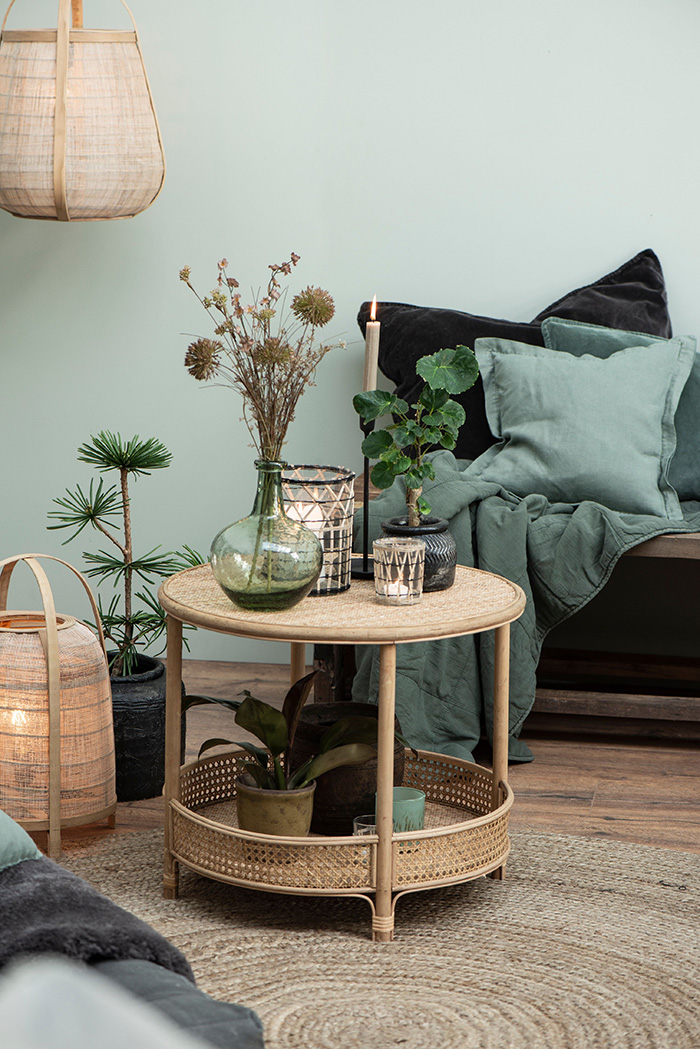
ellajames.co.uk
Cane and rattan
There’s been a fresh revival of interest in cane and rattan furniture in recent years, both for style and eco reasons. It’s a very sustainable, renewable material – made from different parts of the rattan palm that grows in southeast Asia – and is also biodegradable at the end of its life.
High-street and interior retailers are embracing the trend (Ella James is a stylish source of contemporary pieces), but there’s also a strong market for vintage cane and rattan, from the iconic 1970s peacock chair to quirky pieces such as bar trolleys and sunburst mirrors, so it’s well worth trawling auction sites and flea markets looking for a standout piece (Etsy is a treasure trove, including accessories like lampshades and hanging baskets).
The beauty of cane and rattan is that they are surprisingly versatile, working with so many different interior styles, especially those associated with a natural, organic look. They pair perfectly with lush botanical prints and colours, but also suit the pared-back aesthetic of Scandi style, and work well in rustic and bohemian schemes too. An elegant cane piece wouldn’t look out of place in a Victorian period-style home, and a peacock chair is just the thing for a glamorous boudoir setting.
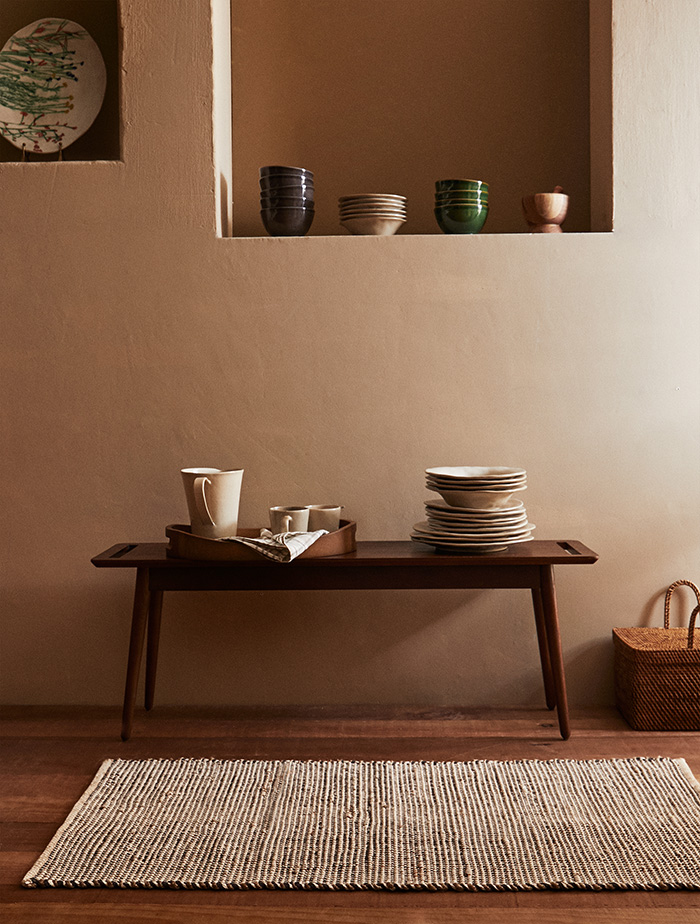
zarahome.com
Ceramics
One of the most versatile of finishing touches, ceramics can play an important role in the look of a space, grounding it through naturally muted colours and tactile texture, or even adding a playful touch of colour and pattern if you go for brighter, bolder pieces.
Stoneware, earthenware and porcelain all come from the earth, and while unglazed pieces are the most biodegradable, the durability of most ceramics mean they tend to have a long, useful life. Giving a new home to a vintage piece is the most sustainable way of acquiring ceramics, but if you’re buying new, try visiting pottery studios that use local clays, or shopping online for handcrafted pieces to support artisan makers and help traditional pottery techniques thrive (Made by Hand Online has one-off designs by ceramic artists).
From the quiet beauty of a single sculptural piece in a muted colour, to a carefully curated group of pots in complementary shades and patterns, there are no hard-and-fast rules about how best to display ceramics. Whether you prefer a busy or pared-back look, the key is to layer the arrangement to get the right balance and avoid pieces looking either lost or hectic.
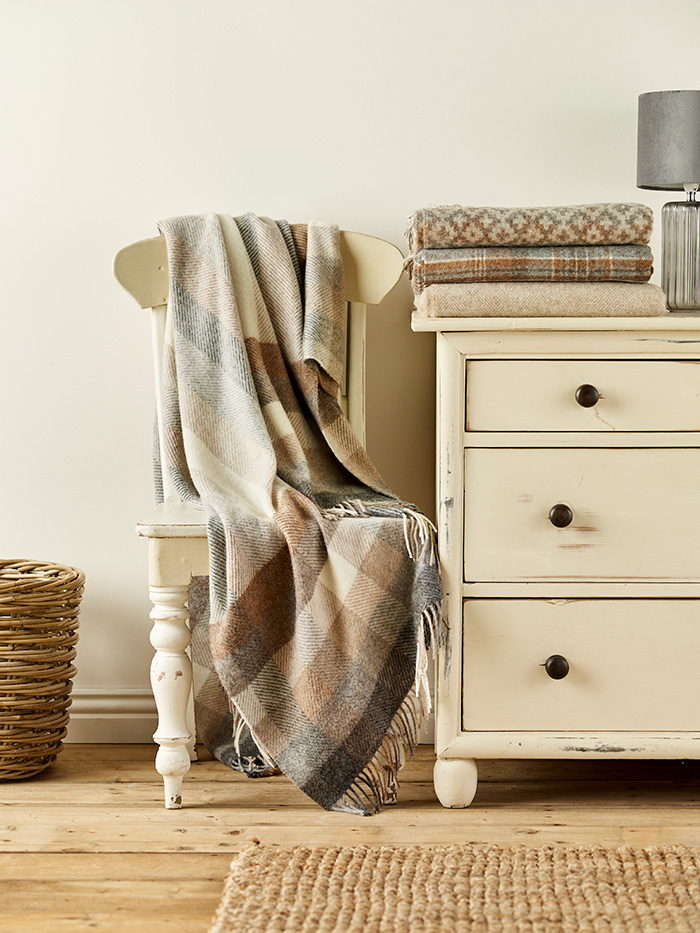
brontebymoon.com
Wool
A naturally high-performance material, wool combines durability, anti-allergenic qualities, natural resistance to fire and water, and with no need for added chemicals. Highly renewable, recyclable and biodegradable, it can be produced both organically and ethically (always look for the Woolmark when buying new), and it looks beautiful too.
Undyed wool is the most natural and an increasingly popular choice – especially for rugs and carpets – but wool fibres can come in many colours, of course, and may be woven to produce traditional fabrics such as tartan or tweed for blankets and upholstery, or knitted or crocheted for a chunkier finish for accessories such as cushions and throws. Wool duvets are becoming increasingly popular too (see Woolroom for bedding filled with ethically sourced British wool). Warm, washable and non-allergenic, they are a natural alternative to conventional polyester-filled duvets, and can also be organic.
A few wool accessories make a room feel instantly cosier, and for extra eco brownie points look for handmade pieces and those made using British wool (we love the gorgeous artisan blankets and cushions at Welsh Otter, handmade using traditional techniques). From blankets and throws draped on beds and armchairs, to soft cushions adding comfort to a functional kitchen bench, wool has that wonderfully tactile snuggle factor that helps make a house a home.
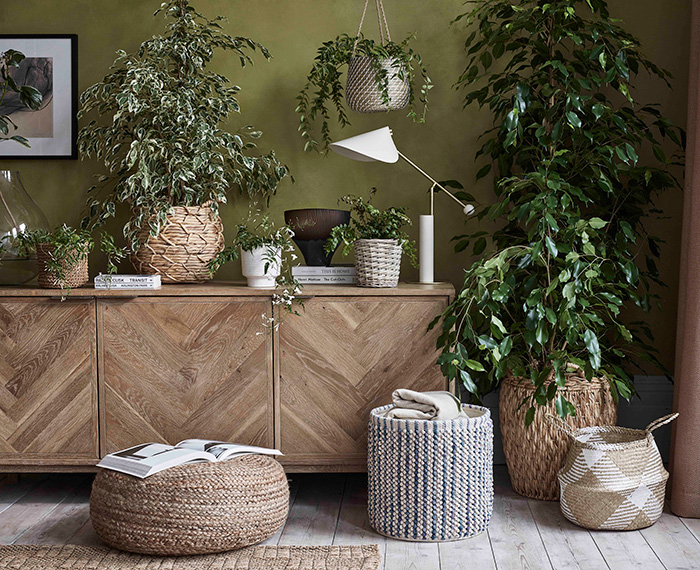
johnlewis.com
Woven plant fibres
Woven crafts are enjoying a resurgence of interest, again largely thanks to the trend for sustainable, natural materials. From seagrass wall hangings to jute rugs, the organic, handmade look in soft earthy tones works beautifully with many styles of interior.
But is it jute, seagrass, coir, sisal or abaca? Many of these terms are used interchangeably, but they originate from different plants, and are all sustainable and biodegradable resources to varying degrees. Jute in particular is highly renewable, made from the stem of the fast-growing corchorus plant. Seagrass is grass grown by or in the sea; coir is from coconut husks; sisal from the long leaves of the agave plant; and abaca is handwoven from the fibres of banana leaves.
Different types of plant fibres have different qualities and uses. Coir is very tough and scratchy, so tends to be used for practical items such as doormats or brushes. Sisal is softer but also versatile and hardwearing, and typically used to make rugs and carpets; it can be woven into both chunky or fine fabrics. Seagrass is one of the softest of the plant fibres, and is most often used to make accessories such as baskets, lampshades and table mats.
For rugs and runners, go to Alternative Flooring or Sisal & Seagrass, while Design Vintage stocks a range of jute and seagrass rugs, baskets, place mats and lampshades with modern rustic appeal.
WORDS: LINDSEY HARRAD
Before you go...
...fancy automatic entry to all future competitions?
Simply register online today for FREE and you will get:
Automatic entry to all current and future competitions.
Access to Reclaim Inspiration - an online visual pinboard for saving all your home and style inspiration.
A regular newsletter of inspiration, ideas and advice.

Save all your articles in one place
Become a Reclaim Member to save all your home and style inspiration. Simply login or register online today for FREE and you will get:
Automatic entry to all current and future competitions.
Access to Reclaim Inspiration - an online visual pinboard for saving all your home and style inspiration.
A regular newsletter of inspiration, ideas and advice.








